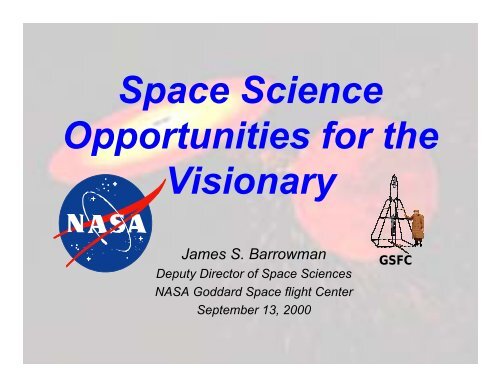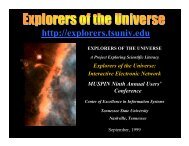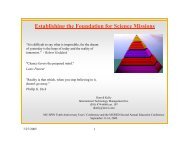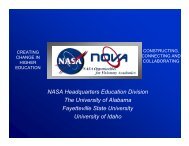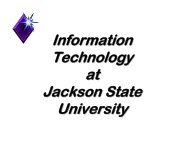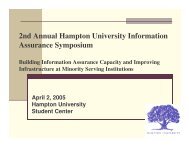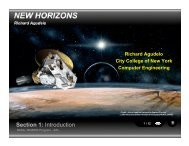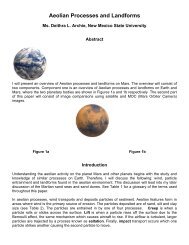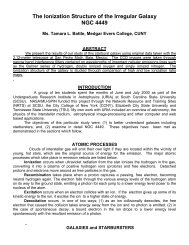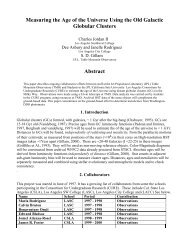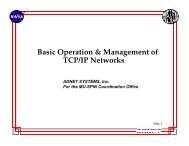Mr. Jim Barrowman - Mu-SPIN - Nasa
Mr. Jim Barrowman - Mu-SPIN - Nasa
Mr. Jim Barrowman - Mu-SPIN - Nasa
You also want an ePaper? Increase the reach of your titles
YUMPU automatically turns print PDFs into web optimized ePapers that Google loves.
Space Science<br />
Opportunities for the<br />
Visionary<br />
James S. <strong>Barrowman</strong><br />
Deputy Director of Space Sciences<br />
NASA Goddard Space flight Center<br />
September 13, 2000<br />
GSFC<br />
1
NASA’s Space Science Enterprise<br />
Mission...<br />
How did the universe begin and evolve?<br />
How did we get here?<br />
How does our environment in space affect us?<br />
Where are we going?<br />
Are we alone?<br />
2
Space Science Themes<br />
NASA Space Science Seeks to...<br />
Explore the Solar System,<br />
Conduct an astronomical search for<br />
planetary systems and the Origin and<br />
distribution of life in the Universe,<br />
Understand the structure and evolution<br />
of the Universe,<br />
Better understand the Sun-Earth<br />
Connection<br />
3
Exploration of the Solar System (ESS)<br />
Goals<br />
• To seek the origin of life and its existence beyond the Earth<br />
• To chart our destiny in the solar system<br />
• To explain the formation and evolution of the solar system and the<br />
Earth within it<br />
4
OCEAN-COVERED<br />
EUROPA<br />
A POSSIBLE HOME<br />
FOR LIFE ORBITING<br />
JUPITER<br />
6
Astronomical Search for Origins (ASO)<br />
Goals<br />
– To understand how galaxies formed in the early universe and to<br />
determine the role of galaxies in the appearance of planetary systems<br />
and life<br />
– To understand how stars and planetary systems form and to determine<br />
whether life-sustaining planets exist around other stars<br />
– To understand how life originated on Earth and to determine whether<br />
it began and may still exist elsewhere as well<br />
7
The Deepest Image Ever<br />
Space Telescope<br />
Imaging Spectrograph<br />
Hubble Deep<br />
Field-South<br />
Jonathan Gardner<br />
(Laboratory for Astronomy and<br />
Solar Physics) et al.<br />
Obtained<br />
8
Next Generation Space Telescope (NGST)<br />
Science goals<br />
What is the shape of the Universe?<br />
How do galaxies evolve?<br />
How do stars and planetary systems form<br />
and interact?<br />
How did the Universe build up its present<br />
elemental/chemical composition?<br />
What is dark matter?<br />
Mission Characteristics<br />
Wavelength Coverage:<br />
Visible and infrared light: 0.6µm
Submillimeter Probe of the Evolution of Cosmic<br />
Structure (SPECS) Mission<br />
Science Goal<br />
SPECS is a bold new mission concept designed<br />
to address fundamental questions about the<br />
Universe, such as:<br />
How did the first stars form from primordial<br />
material, and the first galaxies from pregalactic<br />
structures?<br />
How did galaxies evolve over time?<br />
What is the cosmic history of energy release,<br />
heavy element synthesis, and dust formation?<br />
Program Characteristics Priority:<br />
Telescopes: Three, 3 m aperture, 1 km baseline<br />
High sensitivity, high spatial and moderately<br />
high spectral resolution, and a large field of view<br />
Revolutionary science will be<br />
enabled when we have tools to<br />
study the sub-millimeter sky with<br />
Wavelength range: 40 - 500 µ<br />
Angular resolution: 0.05 arcseconds at 250 µ<br />
(1 km maximum baseline) Hubble-class resolution and<br />
Field of view: 14 arcminuntes at 250 µ sensitivity.<br />
Typical image size<br />
~17,000 x 17,000 resolution elements<br />
Typical sensitivity<br />
~107 Hz-Jy, or 10-19 W/m2 at 100 µ, 1 σ<br />
10
Structure & Evolution of the Universe (SEU)<br />
Goals<br />
– To explain structure in the Universe and forecast our cosmic<br />
destiny<br />
– To explore they cycles of matter and energy in the evolving<br />
universe<br />
– To examine the ultimate limits of gravity and energy in the<br />
universe<br />
11
Gamma Ray Large Area Space<br />
Telescope<br />
GLAST will have 30-100 times<br />
improved Gamma ray sensitivity<br />
over Compton GRO<br />
Launch: 2005<br />
GLAST will look down the beam of<br />
relativistic jets coming from black holes<br />
GLAST will search for the gamma-ray<br />
signature from the decay of exotic<br />
particles (e.g., WIMPS)<br />
GLAST connects the DOE<br />
and NASA communities<br />
12
Image a Black Hole!<br />
Direct image of a black hole event horizon<br />
Fundamental importance to physics<br />
Captures the imagination<br />
MAXIM<br />
0.1 micro arc sec resolution<br />
4-8 µ<br />
arc sec<br />
HST Image<br />
0.1 arc sec resolution<br />
M87<br />
Close to the event horizon the peak<br />
energy is emitted in X-rays<br />
13
Imaging<br />
Spectroscopy<br />
Roadmap to Image a Black Hole<br />
Chandra<br />
0.5 arc sec<br />
XMM<br />
Find them<br />
Optimize MAXIM<br />
Parameters<br />
Constellation-X<br />
100 times<br />
larger area<br />
Conditions in<br />
the inner disk<br />
1000 times<br />
finer imaging<br />
MAXIM<br />
Pathfinder<br />
X-ray<br />
interferometry<br />
first flight<br />
10 Million times<br />
finer imaging<br />
MAXIM<br />
Black hole<br />
imager!<br />
2000 2008 2014 2020<br />
14
The Constellation X-ray Mission<br />
An X-ray Keck Observatory<br />
o Use X-ray spectroscopy to<br />
– Determine black hole parameters and<br />
environment<br />
– Observe formation and evolution of dark matter<br />
structures throughout the Universe<br />
o Mission parameters<br />
– Telescope area: 3 m2 at 1 keV<br />
100 times gain for high resolution spectroscopy<br />
– Spectral resolving power: 300-3,000<br />
5 times improvement at 6 keV<br />
– Band pass: 0.25 to 40 keV<br />
100 times more sensitive at 40 keV<br />
Enable spectroscopy of faint X-ray<br />
source populations<br />
15
System is adjustable<br />
on orbit to achieve<br />
larger baselines<br />
The Black Hole Imager:<br />
MAXIM Observatory Concept<br />
32 optics held in phase to nano-meter<br />
precision over 1 km will give 10<br />
million times better angular<br />
resolution than Chandra<br />
34 formation flying spacecraft<br />
Black hole image!<br />
Optics<br />
10 km<br />
500 km<br />
Detector<br />
Launch: 2020-2025? spacecraft<br />
1 km<br />
Combiner<br />
spacecraft<br />
16
ACCESS: Search for the Origin of Cosmic Rays<br />
Medium energy cosmic rays:<br />
1012 < E < 1015 eV<br />
Where do they come from?<br />
What are they made of?<br />
How are they accelerated?<br />
Large Detectors<br />
Area > 4 m 2<br />
Calorimeter > 0.7 m 2<br />
Total mass 5225 kg<br />
Launch: 2005<br />
17
Science:<br />
EXIST<br />
All Sky Imaging Deep Hard X-ray Survey<br />
– All-sky survey of obscured black holes<br />
in AGN<br />
– Find thousands of nearby “hidden”<br />
black holes<br />
Mission:<br />
8 coded aperture CZT telescopes<br />
(each 40deg FOV; 1 m 2 )<br />
International Space Station attached<br />
payload<br />
All-sky imaging each 90 min orbit<br />
Under study for possible new start in<br />
2008-2013<br />
Credit: Josh Grindlay<br />
18
Approaching the Big Bang<br />
OWL to probe cosmic rays with energy equivalent to 10-27s<br />
after Big Bang<br />
Big Bang Time<br />
LISA to search gravitational<br />
waves<br />
from period of inflation<br />
Hidden Universe<br />
19
Laser Interferometer Space Array (LISA)<br />
LISA uses a laser based<br />
Michaelson interferometer to<br />
accurately monitor the<br />
separation between proof masses<br />
in separate spacecraft.<br />
NASA-ESA project with a launch date of 2010<br />
Measure every second, changes in distance of 10 picometers<br />
over a distance of 3 million miles<br />
That is 100 times smaller than the size of an atom!<br />
20
OWL<br />
The Most Energetic Particles Known!<br />
OWL<br />
1 particle per sq km per century!<br />
Some rare cosmic rays have an energy of<br />
10 21 eV, equivalent to that of universe<br />
~10 -27 s after the big bang!<br />
Acceleration by spinning super-massive black<br />
holes in nearby galaxies?<br />
Decay products from processes related to<br />
those in the early universe?<br />
OWL<br />
OWL will use the Earth as a gigantic detector to observe giant air<br />
showers from space using two telescopes pointing downwards<br />
Determine direction, composition, and spectrum of cosmic rays<br />
Launch: 2010-2015<br />
21
Sun - Earth Connection (SEC)<br />
Goals<br />
– To understand how and why the Sun varies<br />
– To understand how the Earth and the planets respond to<br />
the Sun<br />
– To explore the implications to humanity<br />
22
Science Goal<br />
Solar Terrestrial Probe (STP) Program<br />
To describe the system behavior of the<br />
magnetic variable star, our Sun, and its<br />
interaction with the entire solar system<br />
To understand the critical physics that link<br />
the Sun, Earth, and the interstellar medium<br />
To understand the boundary processes and<br />
dynamics of geospace, the electrical-plasma<br />
environment between the Sun and the Earth.<br />
Missions<br />
TIMED<br />
Solar-B<br />
STEREO<br />
MMS<br />
GEC<br />
MC<br />
23
Geospace<br />
Electrodynamic<br />
Connections<br />
Stereo<br />
SOLAR-B<br />
Magnetospheric<br />
Constellation<br />
24
1<br />
Quest 4 Quest 2<br />
SEC LAUNCH SCHEDULE<br />
PLANNED FUTURE MISSIONS<br />
96 97 98 99 00 01 02 03 04 05 06 07 08 09 10 11 12<br />
25<br />
est<br />
Qu<br />
HESSI<br />
Cluster II<br />
TIMED<br />
STEREO<br />
Solar-B<br />
Solar Probe<br />
Magnetospheric <strong>Mu</strong>ltiscale<br />
Formulation<br />
GEC<br />
Magnetospheric Constellation<br />
SDO IM<br />
RBM Sentinels<br />
Development Launch<br />
Prime Mission<br />
25
Science Goal<br />
Living With a Star (LWS) Program<br />
Living With a Star is a new NASA<br />
initiative to develop the scientific<br />
understanding necessary to effectively<br />
address those aspects of the<br />
Connected Sun-Earth system that<br />
directly affect life and society.<br />
Program Characteristics<br />
Set of four missions to be organized<br />
and launched prior to the next solar<br />
maximum, anticipated for 2011<br />
The Solar Dynamics Observatory, a<br />
single spacecraft mission in<br />
geosynchronous orbit.<br />
Priority<br />
The NAS cites the SDO<br />
Mission as the first priority<br />
project for development of<br />
astronomical observing assets<br />
in space of intermediate size.<br />
26
27<br />
LWS Missions For The Next Solar Maximum<br />
Sentinels<br />
LWS MISSIONS<br />
Solar<br />
Dynamics<br />
Observatory<br />
Ionosphere<br />
Mappers<br />
Radiation<br />
Belt<br />
Mappers<br />
27
Stellar Imager and Seismic Probe (SISP)<br />
Science Goal<br />
Investigate the interaction between<br />
stellar properties - mass, composition,<br />
age, rotation rate, etc., and convection<br />
to determine how magnetic fields are<br />
generated and evolve across the range<br />
of stellar population.<br />
Program Characteristics<br />
Imaging Interferometer in vis-uv<br />
Baselines ~400 m- central beam<br />
combining hub<br />
Located at L2 in solar orbit<br />
Mission duration: 10 years<br />
Produces about 1000 pixels/stellar<br />
image<br />
Priority<br />
SISP is a strategic mission called out I the<br />
FY 2000 SEC Roadmap.<br />
A cross cutting mission with relevance<br />
not only the SEC science theme but<br />
also to the Origins and SEU themes.<br />
Currently studied as DPT candidate<br />
mission.<br />
Required New Technology:<br />
Interferometry & Formation Flying<br />
28
Follow Your<br />
Space Science<br />
Vision….<br />
Start At<br />
http://spacescience.nasa.gov/<br />
29


